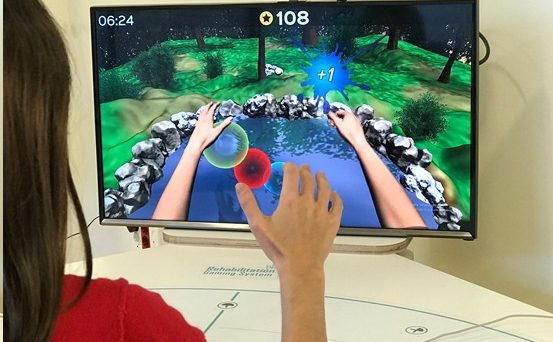
Every two seconds someone suffers a stroke. Around 55 to 75% of stroke survivors will display impairments and will need long-term care and rehabilitation. These staggering numbers highlight a pressing need to resolve the stroke crisis which accounts for a total estimated annual cost of €45 billion. Current rehabilitation treatments for stroke either do not translate in satisfactory long-lasting effects or are too expensive. As a consequence, many patients do not receive the rehabilitation support they need.
One solution to improve the inadequacy of the rehabilitation services is to rely on affordable technologies, such as personal computers with VR-based rehabilitation tools, that would potentially allow a continuum of treatment at the hospital and at home. VR is seen as a promising technology to help patients recover lost physical functions after stroke, mainly because VR allows for a gaming-like training experience which is more entertaining than standard clinical protocols. However, clinical studies report contradictory results on the effectiveness of VR-based rehabilitation and the superiority of this novel approach over standard clinical rehabilitation is not clear.
Could it be that some types of VR-based rehabilitation tools are effective while others are not? And if that is the case, what would make those types more effective?
On the one hand, one could argue that there are too few related studies, or that they are of too low quality, to reveal a true effect. On the other hand, we can look at this lack of evidence from another angle: Could it be that some types of VR-based rehabilitation tools are effective while others are not? And if that is the case, what would make those types more effective?
VR-based rehabilitation is an umbrella term and could include any treatment that uses visual computer technology, from a simple computer screen to a sophisticated robotic device. The effectivity of treatment does not necessarily depend on which technology it uses. For instance, if we want to understand why a pill is effective in treating a specific condition, we have to look at its active components. In rehabilitation, those components could be seen as the neurorehabilitation principles that have been established to be relevant for motor learning and recovery.
Not all VR-based systems, however, are designed based on those principles. Off-the-shelf video game consoles, like Nintendo Wii or Microsoft Xbox, were created for recreational purposes. Nevertheless, they have been increasingly used in studies as tools for rehabilitation, mainly because they are relatively cheap, easy to handle, and support full-body motion control.
These, however, do not guarantee that they are appropriate tools for physical therapy. Systems that are specifically built for rehabilitation may be more suitable to support the therapeutic work.
Current meta-analysis typically did not distinguish between these two types of systems, and further included rehabilitation methods for upper- as well as lower limbs, cognitive functioning, using robotic devices, exoskeletons or other assistive additions. Mixing so different approaches may be the reason why no evident effects have been found so far.
A focused approach
VR systems built specifically for rehabilitation indeed showed a significant impact on upper-limb recovery … In contrast, off-the-shelf consoles did not show this effect.
In our meta-analysis, we aimed to disambiguate the situation by focusing on VR systems that train the upper limb of stroke patients only and that do not rely on any assistive device. Our database search yielded 30 randomized controlled trials reporting measures of motor recovery from 1,473 patients with stroke. The studies were divided into two groups, based on whether their VR-intervention used an off-the-shelf console or a system specifically built or stroke rehabilitation. We then compared the effects of both groups to standard therapy.
Our analysis revealed that VR systems built specifically for rehabilitation indeed showed a significant impact on upper-limb recovery as compared to standard therapy. In contrast, off-the-shelf consoles did not show this effect. The content analysis identified eleven principles of neurorehabilitation that may have an impact on recovery. Specific rehabilitation systems were designed based on six principles: task-specific practice, explicit feedback, increasing difficulty, implicit feedback, variable practice, and promotion of paretic arm use. In contrast, off-the-shelf consoles only incorporated three: dosage, variable practice, and promotion of paretic arm use.
Given our findings, we believe that VR systems if purposefully realized for rehabilitation are valuable tools for recovery. They are well-suited for patients because VR allows them to interact in a safe and entertaining environment, where the exposure to sensorimotor contingencies can be controlled and modulated in a goal-oriented and independent fashion based on scientifically valid principles of rehabilitation. Therefore, future studies should not ask if VR, or any other technology, is useful or not, instead, they should investigate those principles and mechanisms which are relevant for neurorehabilitation, and which technology, including VR, is most appropriate to implement them.
Comments